Identifying the Spatio-Temporal Characteristics of Crime in Liangshan Prefecture, China
Abstract
:1. Introduction
2. Materials and Methods
2.1. Overview of the Study Area
2.2. Data Source and Preprocessing
2.3. Research Methods
2.3.1. Spatial and Temporal Analysis of Geographic Data
2.3.2. Crime Spatio-Temporal Cube Model
2.3.3. Evolution of Spatio-Temporal Patterns of Hot and Cold Spots
3. Results
3.1. Time Distribution Characteristics of Crime
- (1)
- Monthly distribution: January to March and August to December were identified as high incidence periods for property crime; April to July was a low incidence period of property crime.
- (2)
- Daily distribution: Friday had the largest number of incidents in a week, while Sunday had the least. Wednesday and Friday were two peaks of crime incidents during the week. In general, the average number on weekdays was greater than weekends. The 1st day has the largest number, and the 31st day has the least. There was a clear contrast between the first two days and the last two days in a month. Except the first two days, the number of property crimes are within a low range in early month. The number of crimes in middle month are within a high range, and in late month basically within a low range.
- (3)
- Hour distribution: The number of property crimes at 2 A.M. was the highest, and 7 A.M. was the lowest. There were three peak points in the distribution within a day: 2 A.M., 10 A.M., and 9 P.M. The highest incidence period of property crime was 6 P.M. to 3 A.M. From 3 A.M. to 7 A.M., the numbers gradually decreased to a minimum, and during daytime the numbers were below the average level.
- (1)
- Monthly distribution: November had the largest number, and August had the least. January to April and November to December were high incidence periods of violent crime, and May to October was a low incidence period.
- (2)
- Daily distribution: Same as property crime, Friday had the largest number of violent crime and Sunday had the least. Wednesday and Friday were still two peaks during the week. Similarly, the average number on weekdays was greater than weekends. Here there is a difference: the number of violent crimes on the 22nd was the largest, and on the 31st was the least.
- (3)
- Hourly distribution: The highest number of violent crimes occurred at 11 P.M., and the least number at 5 A.M. There were two peak points: 11 P.M. and 1 A.M. Those two points were significantly higher than at other times, which is an abnormally high value area at these times.
- (1)
- Monthly distribution: March had a higher number than any other months, and it was an abnormally high value month. June, July, and December had the least. January to May and September to December were high incidence periods of special crime. Among them, April was an abnormal low number within a high incidence period. Meanwhile, June to August was a low incidence period.
- (2)
- Daily distribution: Unlike property and violent crime, Tuesday had the largest number of special crime, while Sunday had the least. It is roughly decreased from Monday to Sunday. The number of incidents on the 1st was the largest, and the number of incidents on the 31st was the least. Except those two days, the number of cases basically remained stable. Overall, the number of special crime fluctuated less than the other crime types, and it was close to the average number.
- (3)
- Hourly distribution: The largest number of special crime occurred at 3 P.M., and the least number at 5 A.M. Four peak points, namely 10 A.M., midday, 3 P.M., and 9 P.M., are shown in the distribution. This generally indicates that more crimes occur during daytime and fewer at nighttime.
3.2. Spatial Distribution Characteristics of Crime
3.3. Pattern Evolution
4. Discussion
5. Conclusions
- (1)
- Property crime, violent crime, and special crime in Liangshan Prefecture exhibited obvious temporal differences. The various types of crime exhibited different patterns over the month, day, and hour scales. Property crime mainly occurred in autumn and winter; in early month; on Wednesdays and Fridays; and at early morning. Violent crime mainly occurred in winter and spring; on Mondays and Thursdays; and at night. Special crime mainly occurred in the spring and autumn; on Tuesdays; and in the daytime.
- (2)
- The property crime, violent crime, and special crime in Liangshan Prefecture exhibited obvious spatial differences. Towns within the central region area were typical high-frequency crime gathering areas, with higher numbers of violent crime, property crime, and special crime. Obviously, in the western region, only special crime shows low frequency gathering areas. The situation in the eastern region was more complicated. Specifically, the high frequency gathering areas of property crime, violent crime, and special crime was alternately distributed here.
- (3)
- Cases of property crime, violent crime, and special crime in Liangshan Prefecture exhibited obvious spatio-temporal pattern evolution characteristics. From 2013 to 2019, the spatio-temporal evolution patterns of violent crime and property crime exhibited obvious hotspot distributions; Xichang City and surrounding counties had a contrast situation. There were obvious hotspots in the downtown area and its surrounding areas. Due to national policies and public security management, it was significate that the spatio-temporal evolution patterns of special crime shows downtrend in Liangshan Prefecture.
Supplementary Materials
Author Contributions
Funding
Institutional Review Board Statement
Informed Consent Statement
Conflicts of Interest
References
- Kortas, F.; Grigoriev, A.; Piccillo, G. Exploring multi-scale variability in hotspot mapping: A case study on housing prices and crime occurrences in Heerlen. Cities 2022, 128, 103814. [Google Scholar] [CrossRef]
- Hart, T.C.; Fitch, C.H. The predictive accuracy of prospective hot spot mapping and the race and ethnicity of street robbery victims: Could a popular approach to crime fighting be a source of systemic racism? Crime Prev. Community Saf. 2022, 24, 14–29. [Google Scholar] [CrossRef]
- Ratcliffe, J.H. Aoristic signatures and the spatio-temporal analysis of high volume crimepattens. J. Quant. Criminol. 2002, 18, 23–43. [Google Scholar] [CrossRef]
- Rengert, G.F. Auto theft in central Philadelphia. In Policing for Prevention: Reducing Crime, Public Intoxication and Injury; Centre for Crime Policy and Public Safety, School of Justice Administration, Griffith University: Brisbane, Australia, 1997; Volume 7, pp. 199–219. [Google Scholar]
- Braga, A.A. Hot spots policing and crime prevention: A systematic review of Randomized controlled trials. J. Exp. Criminol. 2005, 1, 317–342. [Google Scholar] [CrossRef]
- Hillier, B. Space Is the Machine: A Configurational Theory of Architecture; Cambridge University Press: London, UK, 2007; pp. 110–170. [Google Scholar]
- Liu, L.; Zhang, C.; Feng, J.; Xiao, L.; He, Z.; Zhou, S. The spatial-temporal distribution and influencing factors of fraud crime in ZG city, China. Acta Geogr. Sin. 2017, 72, 315–328. [Google Scholar]
- Feng, J.; Huang, L.; Dong, Y.; Song, L. Research on the spatial-temporal characteristics and mechanism of urban crime: A case study of property crime in Beijing. Acta Geogr. Sin. 2012, 67, 1645–1656. [Google Scholar]
- Thangavelu, A.; Sathyaraj, S.R.; Balasubramanian, S. Assessment of spatial distribution of rural crime mapping in India: A GIS perspective. Int. J. Adv. Remote Sens. GIS 2013, 2, 70–85. [Google Scholar]
- Beconytė, G.; Gružas, K.; Govorov, M. Violent Crime in Lithuania: Trends and Patterns in 2015–2020; AGILE: GIScience Series; Copernicus Publications: Göttingen, Germany, 2022; Volume 3, pp. 1–5. [Google Scholar] [CrossRef]
- Cummings, A.R.; Markandey, N.; Das, H.; Arredondo, C.; Wehenkel, A.; Tiemann, B.L.; Lee, G. The Spill Over of Crime from Urban Centers: An Account of the Changing Spatial Distribution of Violent Crime in Guyana. ISPRS Int. J. Geo-Inf. 2019, 8, 481. [Google Scholar] [CrossRef]
- Wang, Z.; Zhang, H. Understanding the spatial distribution of crime in hot crime areas. Singap. J. Trop. Geogr. 2019, 40, 496–509. [Google Scholar] [CrossRef]
- Wei, X.; Wang, M.; Wu, J. Ethnic minority status, political capital, and executive turnover in China: The moderating role of ethnic autonomous regions. Asia Pac. J. Manag. 2022, 1–26. [Google Scholar] [CrossRef]
- Hamed, K.H.; Rao, A.R. A modified Mann-Kendall trend test for autocorrelated data. J. Hydrol. 1998, 204, 182–196. [Google Scholar] [CrossRef]
- He, Q.; Li, J. The roles of built environment and social disadvantage on the geography of property crime. Cities 2022, 121, 103471. [Google Scholar] [CrossRef]
- Haleem, M.S.; Do Lee, W.; Ellison, M.; Bannister, J. The ‘exposed’population, violent crime in public space and the night-time economy in manchester, UK. Eur. J. Crim. Policy Res. 2021, 27, 335–352. [Google Scholar] [CrossRef]
- Lee, W.D.; Haleem, M.S.; Ellison, M.; Bannister, J. The influence of intra-daily activities and settings upon weekday violent crime in public spaces in Manchester, UK. Eur. J. Crim. Policy Res. 2021, 27, 375–395. [Google Scholar] [CrossRef]
- Gerell, M.; Kronkvist, K. Violent crime, collective efficacy and city-centre effects in Malmö. Br. J. Criminol. 2017, 57, 1185–1207. [Google Scholar] [CrossRef]
- Song, W.; Liu, D. Exploring spatial patterns of property crime risks in Changchun, China. Int. J. Appl. Geospat. Res. (IJAGR) 2013, 4, 80–100. [Google Scholar] [CrossRef]
- Liu, J.; Messner, S.F.; Zhang, L.; Zhuo, Y. Socio-demographic correlates of fear of crime and the social context of contemporary urban China. Am. J. Community Psychol. 2009, 44, 93–108. [Google Scholar] [CrossRef]
- Mondal, S.; Singh, D.; Kumar, R. Crime hotspot detection using statistical and geospatial methods: A case study of Pune City, Maharashtra, India. GeoJournal 2022, 1–17. [Google Scholar] [CrossRef]
- Chainey, S.; Tompson, L.; Uhlig, S. The utility of hotspot mapping for predicting spatial patterns of crime. Secur. J. 2008, 21, 4–28. [Google Scholar] [CrossRef]
- Cheng, T.; Williams, D. Space-time analysis of crime patterns in central London. International Archives of the Photogrammetry. Remote Sens. Spat. Inf. Sci. 2012, 39, 47–52. [Google Scholar]
- Zhu, Q.; Zhang, F.; Liu, S.; Wang, L.; Wang, S. Static or dynamic? Characterize and forecast the evolution of urban crime distribution. Expert Syst. Appl. 2022, 190, 116115. [Google Scholar] [CrossRef]
- Roth, J.J. Crime and specific vacancy types in smaller cities and towns. Crim. Justice Stud. 2022, 35, 93–109. [Google Scholar] [CrossRef]
- Zeng, M.; Mao, Y.; Wang, C. The relationship between street environment and street crime: A case study of Pudong New Area, Shanghai, China. Cities 2021, 112, 103143. [Google Scholar] [CrossRef]
- Jiang, S.; Land, K.C.; Wang, J. Social ties, collective efficacy and perceived neighborhood property crime in Guangzhou, China. Asian J. Criminol. 2013, 8, 207–223. [Google Scholar] [CrossRef]
- Olajuyigbe, A.E.; Adegboyega SA, A.; Adenigba, A.D. Spatial Analysis of Factors Responsible for Spread of Crime Activities in Akure, Nigeria, Using GIS Techniques. Int. J. Criminol. Sociol. Theory 2015, 8, 1–19. [Google Scholar]
- Briz-Redón, Á.; Mateu, J.; Montes, F. Identifying crime generators and spatially overlapping high-risk areas through a nonlinear model: A comparison between three cities of the Valencian region (Spain). Stat. Neerl. 2022, 76, 97–120. [Google Scholar] [CrossRef]
- Ferreira, J.; João, P.; Martins, J. GIS for crime analysis: Geography for predictive models. Electron. J. Inf. Syst. Eval. 2012, 15, 36–49. [Google Scholar]
- Wang, C.; Liu, X.; Yan, Z.; Zhao, Y. Higher education expansion and crime: New evidence from China. China Econ. Rev. 2022, 74, 101812. [Google Scholar] [CrossRef]
- Andresen, M.A.; Linning, S.J.; Malleson, N. Crime at places and spatial concentrations: Exploring the spatial stability of property crime in Vancouver BC, 2003–2013. J. Quant. Criminol. 2017, 33, 255–275. [Google Scholar] [CrossRef]
- Barnum, J.D.; Caplan, J.M.; Kennedy, L.W.; Piza, E.L. The crime kaleidoscope: A cross-jurisdictional analysis of place features and crime in three urban environments. Appl. Geogr. 2017, 79, 203–211. [Google Scholar] [CrossRef] [Green Version]
- Mohammed, A.F.; Baiee, W.R. Analysis of Criminal Spatial Events in GIS for predicting hotspots. In Conference Series: Materials Science and Engineering; IOP Publishing: Bristol, UK, 2020; Volume 928, p. 032071. [Google Scholar]
- Zhong, H.; Yin, J.; Wu, J.; Yao, S.; Wang, Z.; Lv, Z.; Yu, B. Spatial analysis for crime pattern of metropolis in transition using police records and GIS: A case study of Shanghai, China. Int. J. Digit. Contents Technol. Its Appl. 2011, 5, 93–105. [Google Scholar]
- Chauhan, R.; Baraik, V.K. Geo-Information enables crime predictive analysis model. Natl. Geogr. J. India 2022, 68. Available online: https://ngji.in/index.php/ngji/article/view/444 (accessed on 30 June 2022).
- Karimi, S. Spatial analysis of crime distribution in Chalous city using GIS. Geogr. Hum. Relatsh. 2022, 4, 16–29. [Google Scholar]
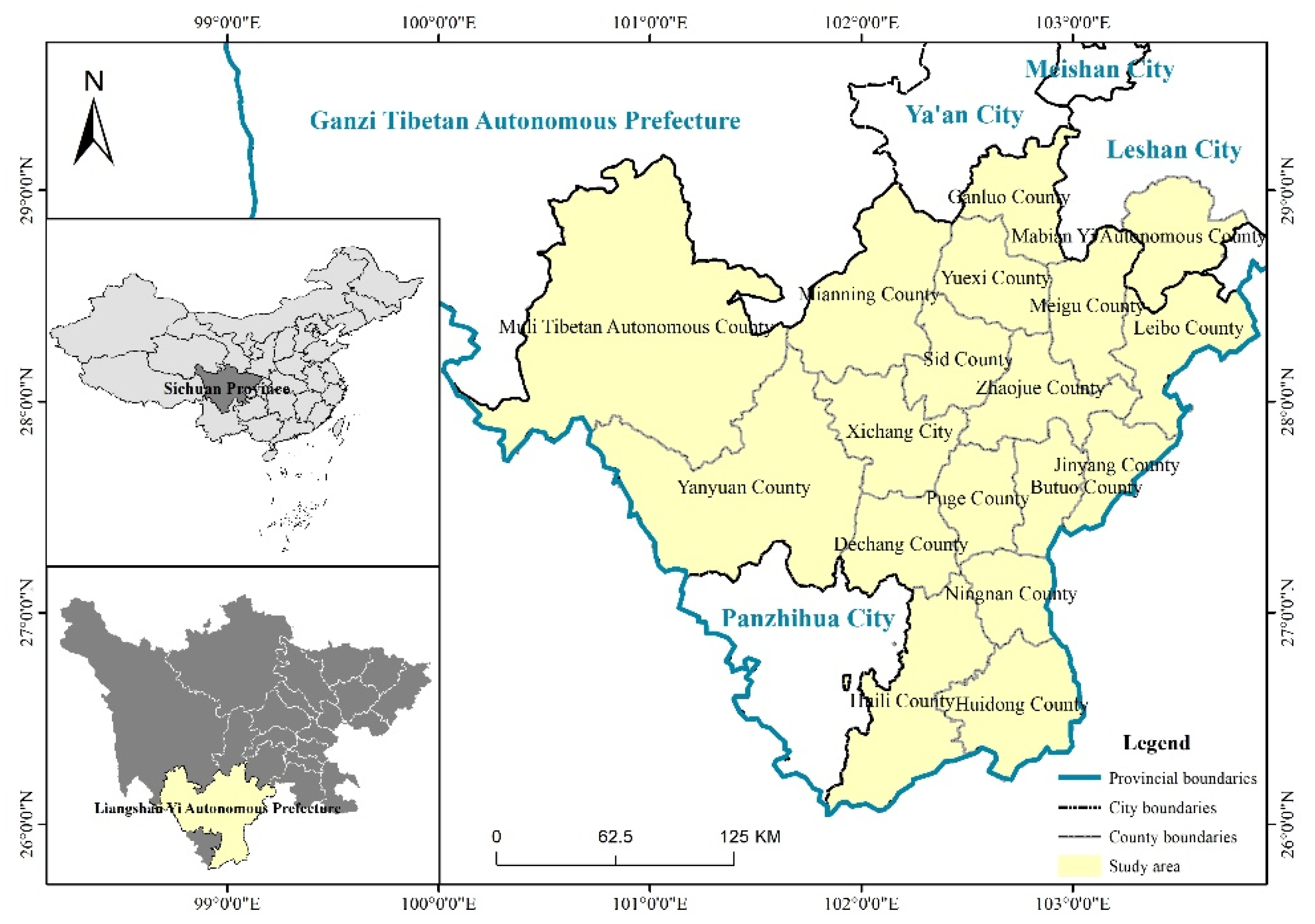




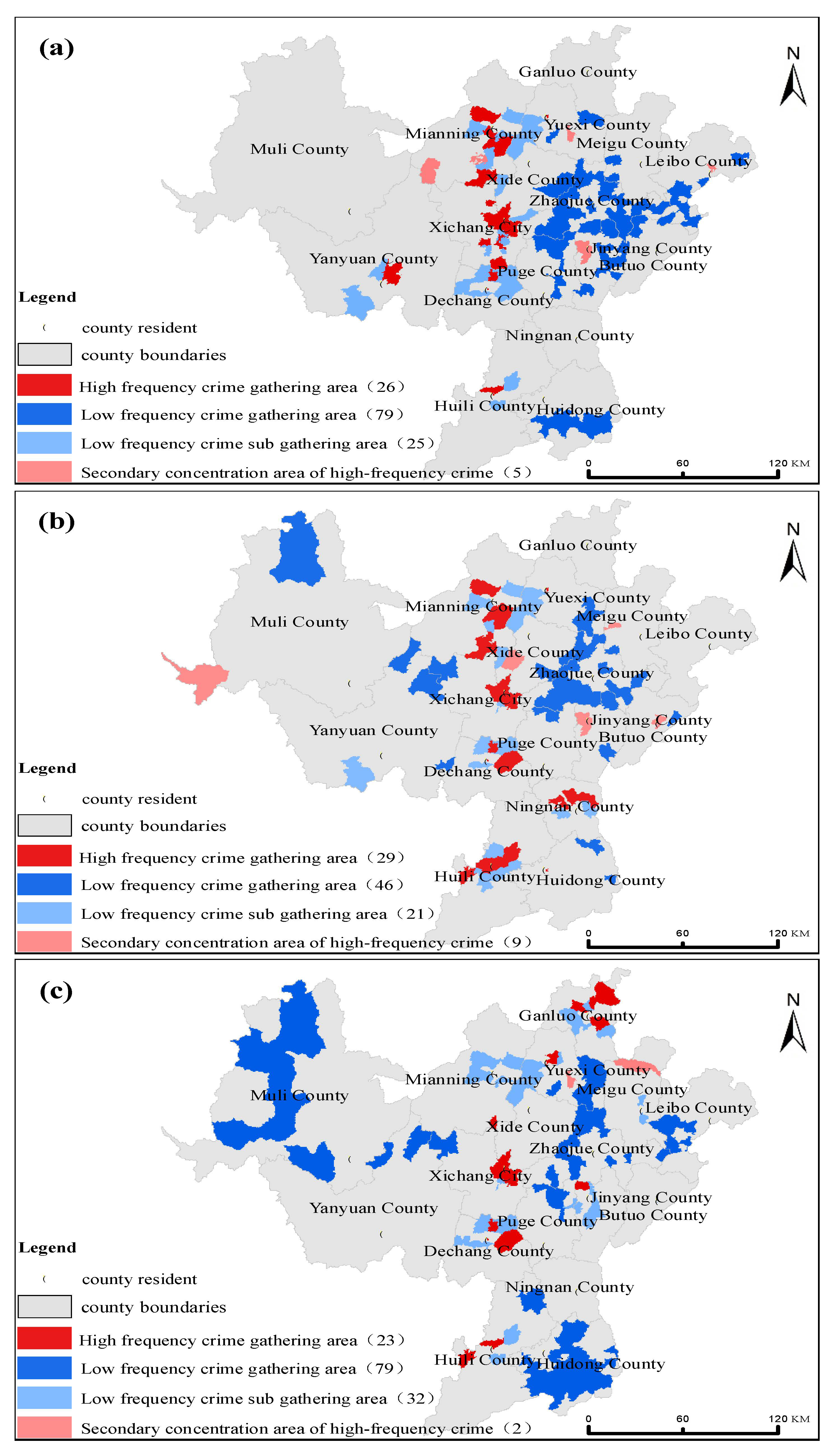

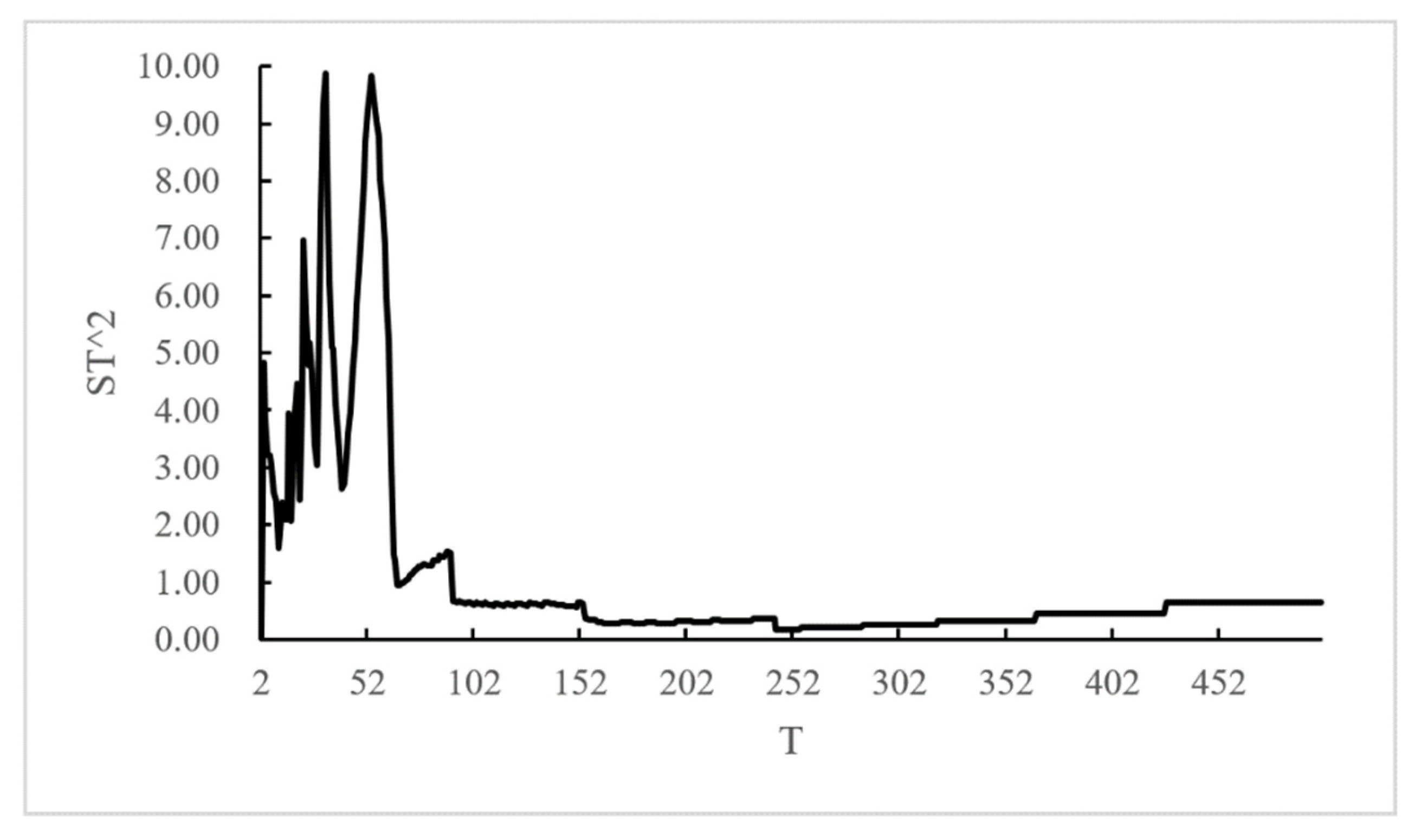
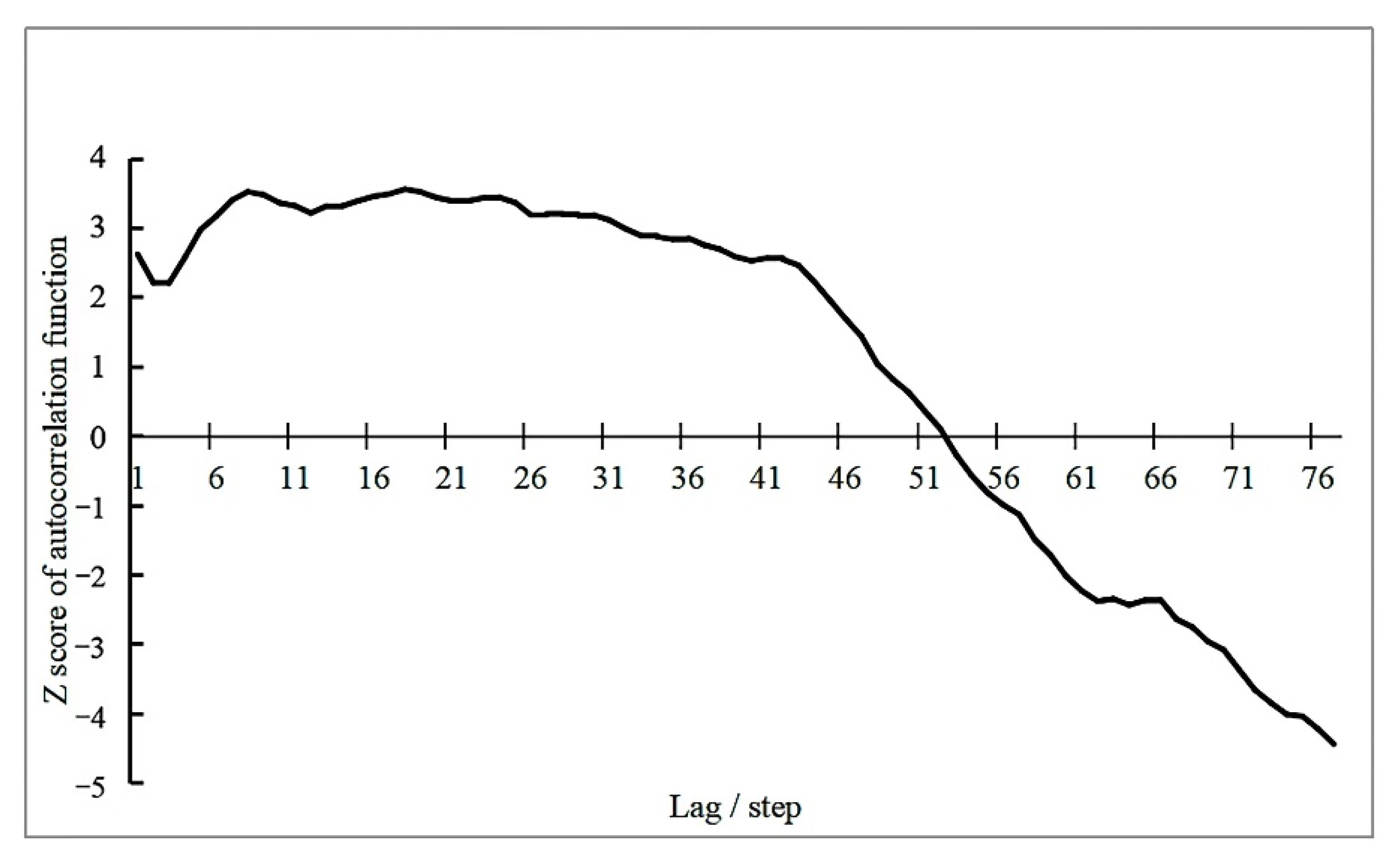
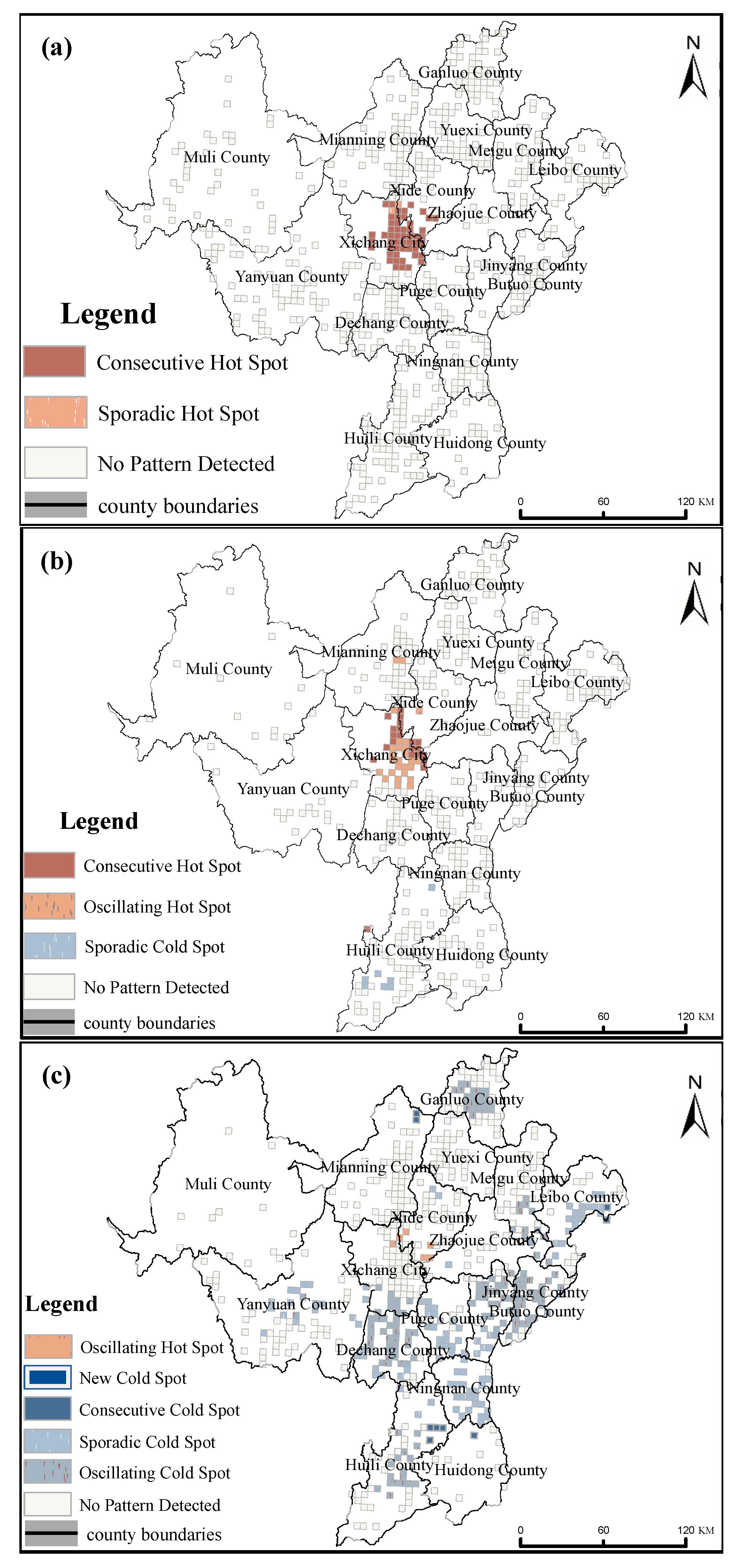
| Type of Crime | Z | I | P |
|---|---|---|---|
| property crime | 6.1161 | 0.0678 | 0.0060 |
| Violent crime | 5.3507 | 0.0877 | 0.0040 |
| Special crime | 4.8380 | 0.0845 | 0.0060 |
Publisher’s Note: MDPI stays neutral with regard to jurisdictional claims in published maps and institutional affiliations. |
© 2022 by the authors. Licensee MDPI, Basel, Switzerland. This article is an open access article distributed under the terms and conditions of the Creative Commons Attribution (CC BY) license (https://creativecommons.org/licenses/by/4.0/).
Share and Cite
Cheng, W.; Rao, Y.; Tang, Y.; Yang, J.; Chen, Y.; Peng, L.; Hao, J. Identifying the Spatio-Temporal Characteristics of Crime in Liangshan Prefecture, China. Int. J. Environ. Res. Public Health 2022, 19, 10862. https://doi.org/10.3390/ijerph191710862
Cheng W, Rao Y, Tang Y, Yang J, Chen Y, Peng L, Hao J. Identifying the Spatio-Temporal Characteristics of Crime in Liangshan Prefecture, China. International Journal of Environmental Research and Public Health. 2022; 19(17):10862. https://doi.org/10.3390/ijerph191710862
Chicago/Turabian StyleCheng, Wuxue, Yajun Rao, Yixin Tang, Jiajia Yang, Yuxin Chen, Li Peng, and Jiangcheng Hao. 2022. "Identifying the Spatio-Temporal Characteristics of Crime in Liangshan Prefecture, China" International Journal of Environmental Research and Public Health 19, no. 17: 10862. https://doi.org/10.3390/ijerph191710862
APA StyleCheng, W., Rao, Y., Tang, Y., Yang, J., Chen, Y., Peng, L., & Hao, J. (2022). Identifying the Spatio-Temporal Characteristics of Crime in Liangshan Prefecture, China. International Journal of Environmental Research and Public Health, 19(17), 10862. https://doi.org/10.3390/ijerph191710862






